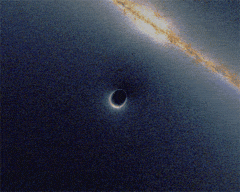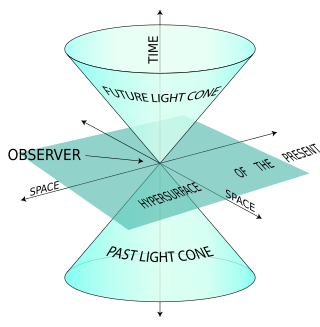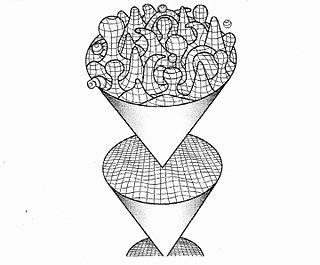
In physics and mathematics, the dimension of a mathematical space is informally defined as the minimum number of coordinates needed to specify any point within it. Thus, a line has a dimension of one (1D) because only one coordinate is needed to specify a point on it – for example, the point at 5 on a number line. A surface, such as the boundary of a cylinder or sphere, has a dimension of two (2D) because two coordinates are needed to specify a point on it – for example, both a latitude and longitude are required to locate a point on the surface of a sphere. A two-dimensional Euclidean space is a two-dimensional space on the plane. The inside of a cube, a cylinder or a sphere is three-dimensional (3D) because three coordinates are needed to locate a point within these spaces.

In physics, Kaluza–Klein theory is a classical unified field theory of gravitation and electromagnetism built around the idea of a fifth dimension beyond the common 4D of space and time and considered an important precursor to string theory. In their setup, the vacuum has the usual 3 dimensions of space and one dimension of time but with another microscopic extra spatial dimension in the shape of a tiny circle. Gunnar Nordström had an earlier, similar idea. But in that case, a fifth component was added to the electromagnetic vector potential, representing the Newtonian gravitational potential, and writing the Maxwell equations in five dimensions.
M-theory is a theory in physics that unifies all consistent versions of superstring theory. Edward Witten first conjectured the existence of such a theory at a string theory conference at the University of Southern California in 1995. Witten's announcement initiated a flurry of research activity known as the second superstring revolution. Prior to Witten's announcement, string theorists had identified five versions of superstring theory. Although these theories initially appeared to be very different, work by many physicists showed that the theories were related in intricate and nontrivial ways. Physicists found that apparently distinct theories could be unified by mathematical transformations called S-duality and T-duality. Witten's conjecture was based in part on the existence of these dualities and in part on the relationship of the string theories to a field theory called eleven-dimensional supergravity.

In physics, spacetime, also called the space-time continuum, is a mathematical model that fuses the three dimensions of space and the one dimension of time into a single four-dimensional continuum. Spacetime diagrams are useful in visualizing and understanding relativistic effects, such as how different observers perceive where and when events occur.
A wormhole is a hypothetical structure connecting disparate points in spacetime, and is based on a special solution of the Einstein field equations.

A gravitational singularity, spacetime singularity or simply singularity is a condition in which gravity is predicted to be so intense that spacetime itself would break down catastrophically. As such, a singularity is by definition no longer part of the regular spacetime and cannot be determined by "where" or "when". Gravitational singularities exist at a junction between general relativity and quantum mechanics; therefore, the properties of the singularity cannot be described without an established theory of quantum gravity. Trying to find a complete and precise definition of singularities in the theory of general relativity, the current best theory of gravity, remains a difficult problem. A singularity in general relativity can be defined by the scalar invariant curvature becoming infinite or, better, by a geodesic being incomplete.
The world line of an object is the path that an object traces in 4-dimensional spacetime. It is an important concept of modern physics, and particularly theoretical physics.
In general relativity, a white hole is a hypothetical region of spacetime and singularity that cannot be entered from the outside, although energy-matter, light and information can escape from it. In this sense, it is the reverse of a black hole, from which energy-matter, light and information cannot escape. White holes appear in the theory of eternal black holes. In addition to a black hole region in the future, such a solution of the Einstein field equations has a white hole region in its past. This region does not exist for black holes that have formed through gravitational collapse, however, nor are there any observed physical processes through which a white hole could be formed.

In special and general relativity, a light cone is the path that a flash of light, emanating from a single event and traveling in all directions, would take through spacetime.

Quantum foam or spacetime foam is a theoretical quantum fluctuation of spacetime on very small scales due to quantum mechanics. The theory predicts that at these small scales, particles of matter and antimatter are constantly created and destroyed. These subatomic objects are called virtual particles. The idea was devised by John Wheeler in 1955.

In theoretical physics, a Penrose diagram is a two-dimensional diagram capturing the causal relations between different points in spacetime through a conformal treatment of infinity. It is an extension of the Minkowski diagram of special relativity where the vertical dimension represents time, and the horizontal dimension represents a space dimension. Using this design, all light rays take a 45° path . Locally, the metric on a Penrose diagram is conformally equivalent to the metric of the spacetime depicted. The conformal factor is chosen such that the entire infinite spacetime is transformed into a Penrose diagram of finite size, with infinity on the boundary of the diagram. For spherically symmetric spacetimes, every point in the Penrose diagram corresponds to a 2-dimensional sphere .

In theoretical physics, quantum field theory in curved spacetime (QFTCS) is an extension of quantum field theory from Minkowski spacetime to a general curved spacetime. This theory uses a semi-classical approach; it treats spacetime as a fixed, classical background, while giving a quantum-mechanical description of the matter and energy propagating through that spacetime. A general prediction of this theory is that particles can be created by time-dependent gravitational fields (multigraviton pair production), or by time-independent gravitational fields that contain horizons. The most famous example of the latter is the phenomenon of Hawking radiation emitted by black holes.

Keiichi Morisato is a major fictional character in the popular manga Oh My Goddess! and in the anime of the same name and is voiced by Masami Kikuchi. His name is often abbreviated as "K1".

A five-dimensional space is a space with five dimensions. In mathematics, a sequence of N numbers can represent a location in an N-dimensional space. If interpreted physically, that is one more than the usual three spatial dimensions and the fourth dimension of time used in relativistic physics.
The DGP model is a model of gravity proposed by Gia Dvali, Gregory Gabadadze, and Massimo Porrati in 2000. The model is popular among some model builders, but has resisted being embedded into string theory.
Complex spacetime is a mathematical framework that combines the concepts of complex numbers and spacetime in physics. In this framework, the usual real-valued coordinates of spacetime are replaced with complex-valued coordinates. This allows for the inclusion of imaginary components in the description of spacetime, which can have interesting implications in certain areas of physics, such as quantum field theory and string theory.









